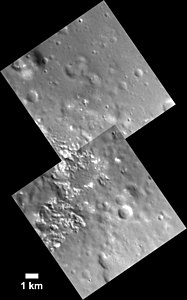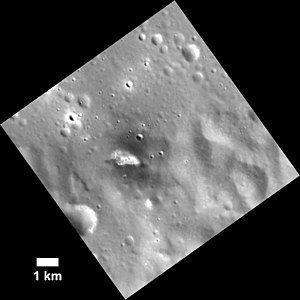Rustaveli (crater)
Appearance
 MESSENGER image | |
| Planet | Mercury |
|---|---|
| Coordinates | 52°25′N 277°16′W / 52.41°N 277.26°W |
| Quadrangle | Hokusai |
| Diameter | 200.0 km (124.3 mi) |
| Eponym | Shota Rustaveli |

Rustaveli is a crater on Mercury. Its name was adopted by the International Astronomical Union in 2012, after the Georgian poet Shota Rustaveli.[1]
Rustaveli is one of 110 peak ring basins on Mercury.[2] The interior has mostly been flooded by impact melt or volcanic deposits.[3]
A confirmed dark spot is present in northern Rustaveli.[4] This dark spot is associated with hollows (see below).
To the east of Rustaveli is Kulthum crater. The crater Copland and Nathair Facula are to the southwest.
Hollows
[edit]Hollows are present on the floor of Rustaveli crater.
-
Hollows associated with the dark spot in north-central Rustaveli
-
Bright hollow north of the center of Rustaveli
-
Hollow on the southern rim with halo of low reflectance material
References
[edit]- ^ "Rustaveli". Gazetteer of Planetary Nomenclature. IAU/NASA/USGS. Retrieved 27 March 2020.
- ^ Chapman, C. R., Baker, D. M. H., Barnouin, O. S., Fassett, C. I., Marchie, S., Merline, W. J., Ostrach, L. R., Prockter, L. M., and Strom, R. G., 2018. Impact Cratering of Mercury. In Mercury: The View After MESSENGER edited by Sean C. Solomon, Larry R. Nittler, and Brian J. Anderson. Cambridge Planetary Science. Chapter 9.
- ^ Mercury's Smile, published August 5, 2011. NASA/Johns Hopkins University Applied Physics Laboratory/Carnegie Institution of Washington.
- ^ Zhiyong Xiao, Robert G. Strom, David T. Blewett, Paul K. Byrne, Sean C. Solomon, Scott L. Murchie, Ann L. Sprague, Deborah L. Domingue, Jörn Helbert, 2013. Dark spots on Mercury: A distinctive low-reflectance material and its relation to hollows. Journal of Geophysical Research Planets. doi.org/10.1002/jgre.20115



